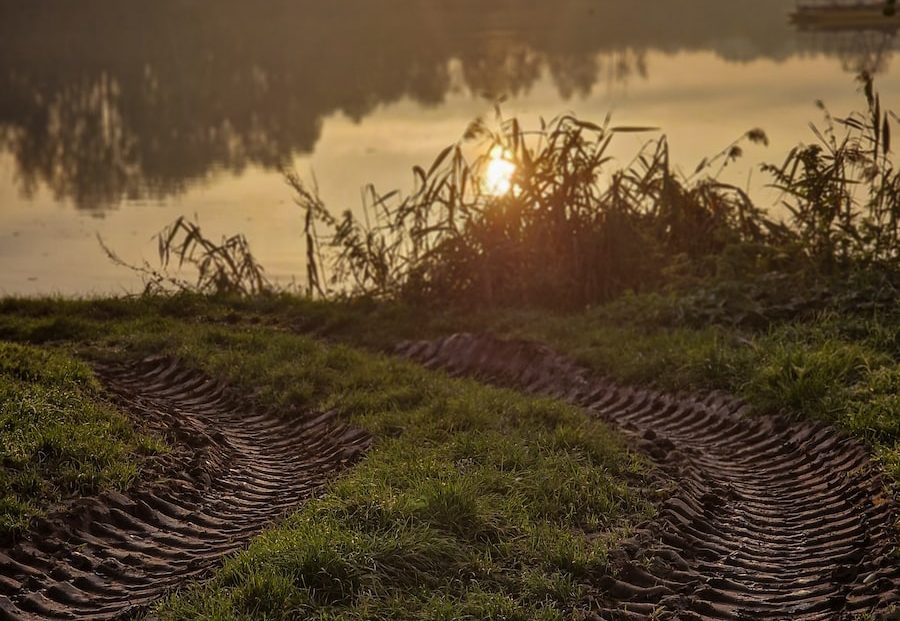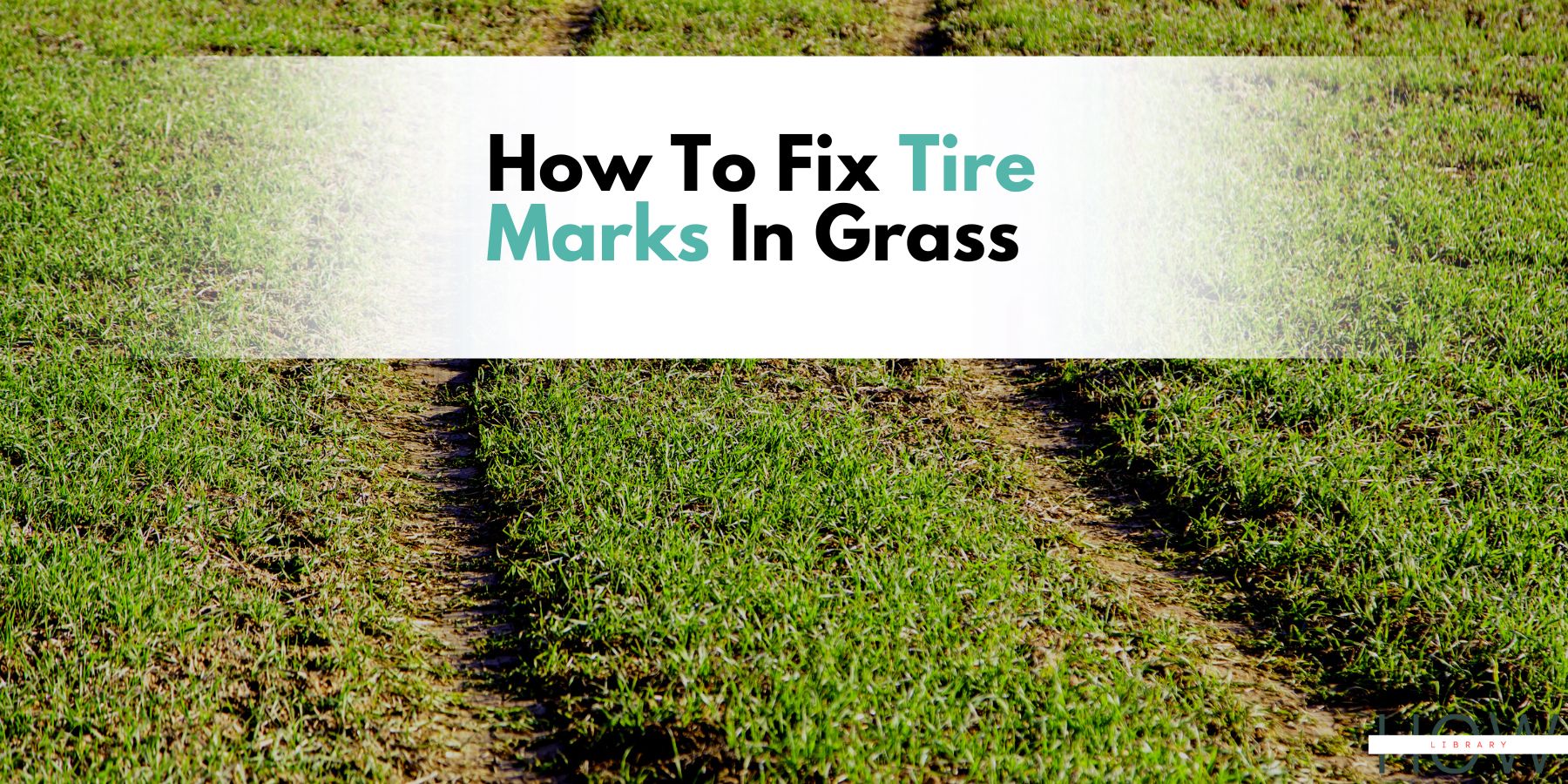Tire marks in the grass can be unsightly and detract from the overall appearance of your lawn. They can also damage the grass, as the vehicle’s weight can compress the soil and kill the grass beneath.
If you have tire marks in your grass, it’s important to take the right steps that will fix them as soon as possible. Not only will this improve the appearance of your lawn, but it will also help to prevent further damage to the grass.
You can use different methods to fix tire marks in the grass, including reseeding, using a grass patch repair product, and applying a top dressing of soil and compost.
Causes of Tire Marks
Before you can fix tire marks in the grass, it’s important to understand how they occur. Tire marks or ruts can be caused by various objects such as cars, motorcycles, and even bicycles. When a vehicle or other object moves over the soil, the object’s weight can cause the soil to compress and sink, creating a divot or rut.
Cars and motorcycles are particularly prone to creating tire marks or ruts due to their heavy weight and the pressure they exert on the ground as they move. The tires of these vehicles can also cause the soil to sink as they grip and push against the ground, particularly on softer surfaces such as grass or dirt.
Bicycles, particularly those ridden by children, can also cause tire marks or ruts in the ground. While they may not be as heavy as cars or motorcycles, the smaller size of the tires and the repetitive motion of pedaling can cause the soil to sink and create divots.
Accessing The Damage

Assessing the damage to the grass is important in fixing tire marks in grass because it helps determine the best course of action for repairing the tire marks. If the ruts are shallow, it may be possible to simply smooth out the surface with a rake or other tool and let the grass grow back on its own. However, if the ruts are deep, filling the holes with soil and/or seed the area may be necessary to encourage new grass growth.
It’s also important to consider the time of year and the overall health of the grass. The repair process may be faster and easier if the tire marks are in an area with healthy, actively growing grass. However, if the tire marks are in a dry or dormant area, it may take longer for the grass to recover, and additional measures may be needed to support new growth.
Overall, properly assessing the damage and understanding the current conditions of the grass will help you determine the best approach for repairing tire marks in the grass.
Small Ruts
- Measure the depth of the ruts to ensure they are no more than 10 cm deep to apply this method.
- Use a garden fork to lift the affected turf by inserting it underneath the rut and pulling it up. Aim to lift the turf a few cm ahead of the unaffected grass.
- Repeat this process around the affected area until the ruts are filled, and the turf is level.
- Water the area lightly to encourage the grassroots to take hold and repair the damaged turf.
- If the ruts are deep or widespread, you may need to add topsoil or grass seed to the affected area in addition to using the garden fork method to fully repair the damage.
Remember to always be gentle when working with your grass, as rough handling can cause further damage. With patience and care, you can fix small ruts in your lawn and have it look healthy and green again.
Larger Ruts
- Cut the grass along three sides of the rut using a spade; This will allow you to lift and then fold the grass over, exposing the soil beneath.
- Loosen the soil below the rut with a garden fork or spade to help it settle back into place and create a level surface.
- If the soil has not been leveled after loosening it, add a little sandy loam or turf it underlay to bring it back to the desired level. This will ensure that the grass grows back evenly.
- If you realize the rut is seriously damaged, consider replacing it with turf rolls from a local supplier. Choose a variety matching your lawn and cut the rolls to size. Lay the turf over the prepared soil.
- Once the soil and turf are in place, fold the grass back over the top of the soil and let it grow back in. This process may take a few weeks, so be patient.
Measures You Should Take To Prevent Ruts In Your Lawn
- Repair any existing ruts; If you have ruts in your lawn already, the first step is to repair them. Fill the ruts with topsoil or compost, then reseed the grass.
- Avoid heavy traffic on your lawn; If you have a lot of foot traffic or vehicles driving on your lawn, it can cause ruts to form. Try to keep traffic to a minimum, or consider paving a walkway or driveway to reduce the amount of grass that needs to bear the weight of traffic.
- Choose grass types resistant to ruts; Some types, such as fescue and bluegrass, are more resistant to ruts than others. Consider planting these types of grass in areas prone to heavy traffic.
- Water your lawn regularly; A well-watered lawn is more resilient and able to withstand heavy traffic. Be sure to water your lawn deeply and consistently to keep it healthy.
- Use a lawn roller; If you have a lot of traffic on your lawn, a lawn roller can help to even out the grass and prevent ruts from forming. Just be sure to use it carefully to avoid damaging the grass.
- Finally, you should add a sign that says “KEEP OFF THE GRASS” on your lawn. You should buy a sign board and keep it in all directions to prevent vehicles from stepping into your lawn.
Will Tire Tracks In Grass Go Away?
Generally speaking, Yes. However, it’s important to understand that tire tracks in the grass will not go away overnight. It depends on many factors, such as the type of soil, how heavy the vehicle is, the type of tires that cause the tracks, the speed of the vehicle and other factors.
How Do You Fill In Uneven Grass Spots?
- Determine the cause of the unevenness; This could be due to various factors, such as soil compaction, drainage issues, or weeds. Identifying the cause will help you determine the best course of action.
- Remove any weeds or debris from the area; You will make it easier for new grass to grow and help prevent further damage to the lawn.
- Rake the area to loosen the soil and remove any dead grass; This will allow new grass seeds to make contact with the soil and establish roots more easily.
- Apply a layer of topsoil to the area if the soil is poor quality or if the spot is particularly deep. This will provide a good base for the new grass seeds to grow.
- Spread grass seed over the area, following the recommended seed rate for your region and grass type; Water the area thoroughly to help the seeds germinate.
- Keep the area moist by watering regularly and applying a layer of mulch to help retain moisture; As the grass grows, be sure to mow it regularly to promote healthy growth.
In conclusion, fixing tire marks in grass can be simple if addressed quickly and properly. The first step is to water the affected area thoroughly to soften the ground and make it easier to work with. Next, use a rake or shovel to loosen and fluff up the grass and soil in the tire marks. If the tire marks are deep or the grass is damaged, you may need to fill in any gaps with topsoil or grass seed. Once the area is repaired, make sure to keep it well-watered and fertilized to encourage healthy regrowth.


What are some effective ways to fix tire marks in the grass without causing harm to the surrounding plants and soil? I have a lot of foot traffic in my garden and often find myself dealing with this issue. I want to make sure I’m using the right techniques to repair the damage without causing any additional harm.
One effective way to fix tire marks in the grass is to use a combination of raking and topdressing. To start, use a rake to gently lift and fluff up the damaged grass blades. This will help to loosen any compacted soil and encourage the grass to grow back. Next, apply a thin layer of topdressing material, such as compost or finely ground bark, over the affected area. This will help to add nutrients back into the soil and encourage the grass to grow.
It’s important to be gentle when fixing tire marks in the grass and to avoid using too much topdressing material, as this can smother the grass and cause further damage. It’s also a good idea to water the affected area regularly to help the grass recover and to keep the topdressing material in place.
Other methods that can be used to fix tire marks in the grass include reseeding and sod installation. However, these methods may be more time-consuming and costly compared to raking and topdressing. As always, it’s important to pay attention to the health of the surrounding plants and soil when working on any garden repair project.
Thank you so much for your helpful answer! I really appreciate the step-by-step instructions and the emphasis on being gentle and careful when fixing the tire marks. I’ll definitely keep these tips in mind and make sure to water the affected area regularly. Your advice has been very valuable and I’m confident it will help me successfully repair the damage in my garden. Thank you again for your help!